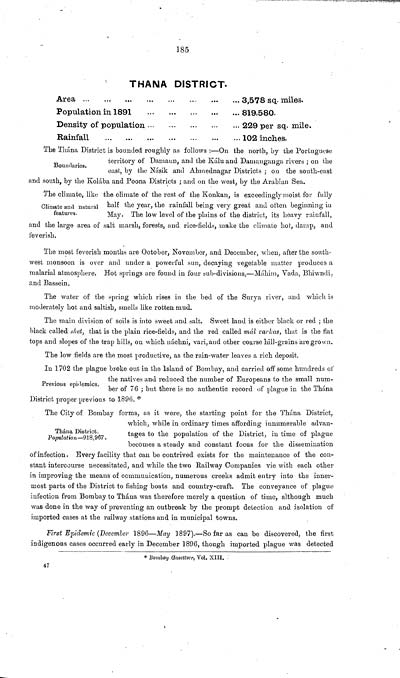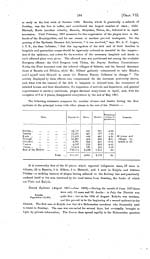Medicine - Disease > Bombay plague: being a history of the progress of plague in the Bombay presidency from September 1896 to June 1899
(253) Page 185
Download files
Individual page:
Thumbnail gallery: Grid view | List view

185
THANA DISTRICT.
Area ... ... ... ... ... ... ... ... 3,578 sq. miles.
Population in 1891 ... ... ... ... ... 819,580.
Density of population ... ... ... ... 229 per sq. mile.
Rainfall ... ... ... ... ... ... ... ... 102 inches.
Boundaries.
The Thna District is bounded roughly as follows :-On the north, by the Portuguese
territory of Damaun, and the Klu and Damanganga rivers ; on the
east, by the Nsik and Ahmednagar Districts ; on the south-east
and south, by the Kolba and Poona Districts ; and on the west, by the Arabian Sea.
Climate and natural
features.
The climate, like the climate of the rest of the Konkan, is exceedingly moist for fully
half the year, the rainfall being very great and often beginning in
May. The low level of the plains of the district, its heavy rainfall,
and the large area of salt marsh, forests, and rice-fields, make the climate hot, damp, and
feverish.
The most feverish months are October, November, and December, when, after the south-
west monsoon is over and under a powerful sun, decaying vegetable matter produces a
malarial atmosphere. Hot springs are found in four sub-divisions,-Mhim, Vada, Bhiwndi.
and Bassein.
The water of the spring which rises in the bed of the Surya river, and which is
moderately hot and saltish, smells like rotten mud.
The main division of soils is into sweet and salt. Sweet land is either black or red ; the
black called shet, that is the plain rice-fields, and the red called ml rarkas, that is the fiat
tops and slopes of the trap hills, on which nchni, vari, and other coarse hill-grains are grown.
The low fields are the most productive, as the rain-water leaves a rich deposit.
Previous epidemics.
In 1702 the plague broke out in the Island of Bombay, and carried off some hundreds of
the natives and reduced the number of Europeans to the small num-
ber of 76 ; but there is no authentic record of plague in the Thna
District proper previous to 1896. *
Thna District.
Population- 918,967.
The City of Bombay forms, as it were, the starting point for the Thna District,
which, while in ordinary times affording innumerable advan-
tages to the population of the District, in time of plague
becomes a steady and constant focus for the dissemination
of infection. Every facility that can be contrived exists for the maintenance of the con-
stant intercourse necessitated, and while the two Railway Companies vie with each other
in improving the means of communication, numerous creeks admit entry into the inner-
most parts of the District to fishing boats and country-craft. The conveyance of plague
infection from Bombay to Thna was therefore merely a question of time, although much
was done in the way of preventing an outbreak by the prompt detection and isolation of
imported cases at the railway stations and in municipal towns.
First Epidemic (December 1896-May 1897).-Sofaras can be discovered, the first
indigenous cases occurred early in December 1896, though imported plague was detected
* Bombay Gazetteer, Vol. XIII.
47
THANA DISTRICT.
Area ... ... ... ... ... ... ... ... 3,578 sq. miles.
Population in 1891 ... ... ... ... ... 819,580.
Density of population ... ... ... ... 229 per sq. mile.
Rainfall ... ... ... ... ... ... ... ... 102 inches.
Boundaries.
The Thna District is bounded roughly as follows :-On the north, by the Portuguese
territory of Damaun, and the Klu and Damanganga rivers ; on the
east, by the Nsik and Ahmednagar Districts ; on the south-east
and south, by the Kolba and Poona Districts ; and on the west, by the Arabian Sea.
Climate and natural
features.
The climate, like the climate of the rest of the Konkan, is exceedingly moist for fully
half the year, the rainfall being very great and often beginning in
May. The low level of the plains of the district, its heavy rainfall,
and the large area of salt marsh, forests, and rice-fields, make the climate hot, damp, and
feverish.
The most feverish months are October, November, and December, when, after the south-
west monsoon is over and under a powerful sun, decaying vegetable matter produces a
malarial atmosphere. Hot springs are found in four sub-divisions,-Mhim, Vada, Bhiwndi.
and Bassein.
The water of the spring which rises in the bed of the Surya river, and which is
moderately hot and saltish, smells like rotten mud.
The main division of soils is into sweet and salt. Sweet land is either black or red ; the
black called shet, that is the plain rice-fields, and the red called ml rarkas, that is the fiat
tops and slopes of the trap hills, on which nchni, vari, and other coarse hill-grains are grown.
The low fields are the most productive, as the rain-water leaves a rich deposit.
Previous epidemics.
In 1702 the plague broke out in the Island of Bombay, and carried off some hundreds of
the natives and reduced the number of Europeans to the small num-
ber of 76 ; but there is no authentic record of plague in the Thna
District proper previous to 1896. *
Thna District.
Population- 918,967.
The City of Bombay forms, as it were, the starting point for the Thna District,
which, while in ordinary times affording innumerable advan-
tages to the population of the District, in time of plague
becomes a steady and constant focus for the dissemination
of infection. Every facility that can be contrived exists for the maintenance of the con-
stant intercourse necessitated, and while the two Railway Companies vie with each other
in improving the means of communication, numerous creeks admit entry into the inner-
most parts of the District to fishing boats and country-craft. The conveyance of plague
infection from Bombay to Thna was therefore merely a question of time, although much
was done in the way of preventing an outbreak by the prompt detection and isolation of
imported cases at the railway stations and in municipal towns.
First Epidemic (December 1896-May 1897).-Sofaras can be discovered, the first
indigenous cases occurred early in December 1896, though imported plague was detected
* Bombay Gazetteer, Vol. XIII.
47
Set display mode to: Large image | Zoom image | Transcription
Images and transcriptions on this page, including medium image downloads, may be used under the Creative Commons Attribution 4.0 International Licence unless otherwise stated. ![]()
| India Papers > Medicine - Disease > Bombay plague: being a history of the progress of plague in the Bombay presidency from September 1896 to June 1899 > (253) Page 185 |
|---|
| Permanent URL | https://digital.nls.uk/74586474 |
|---|---|
| Description | Chap. VII. Thana District. |




